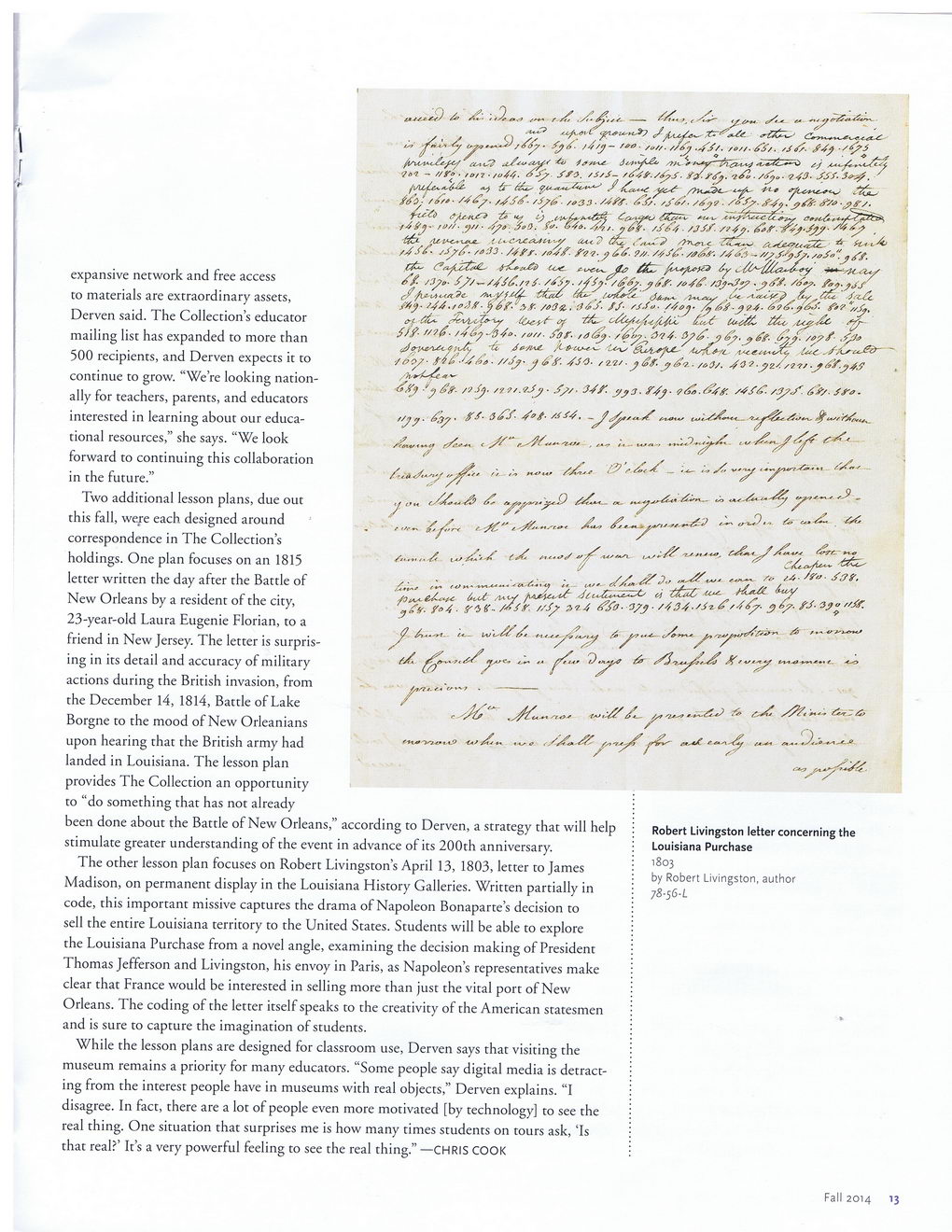This text was obtained via automated optical character recognition.
It has not been edited and may therefore contain several errors.
w) 4*> f 2 e*<4 r/t* ^',sS, ----------- //f.< > e
*s? -^*^i 0^0 / ^ry • ^J}4- /■4/*J~ /&&■ /a//. •*$',£/. /&//•/&/.
asiC3 ^ 4 4'***-£-■ /Wi..S
<2^^ — //&*> • fof 7 ■ /o44- Sfo. /S/J—^ /v4$r-/^s ■ t?3>-ydy.
•a
■j?/.
/?
tzr
,y
r
expansive network and free access to materials are extraordinary assets,
Derven said. The Collection’s educator mailing list has expanded to more than 500 recipients, and Derven expects it to continue to grow. “We’re looking nationally for teachers, parents, and educators interested in learning about our educational resources,” she says. “We look forward to continuing this collaboration in the future.”
Two additional lesson plans, due out this fall, were each designed around correspondence in The Collection’s holdings. One plan focuses on an 1815 letter written the day after the Battle of New Orleans by a resident of the city,
23-year-old Laura Eugenie Florian, to a friend in New Jersey. The letter is surprising in its detail and accuracy of military actions during the British invasion, from the December 14, 1814, Battle of Lake Borgne to the mood of New Orleanians upon hearing that the British army had landed in Louisiana. The lesson plan provides The Collection an opportunity to “do something that has not already
been done about the Battle of New Orleans,” according to Derven, a strategy that will help stimulate greater understanding of the event in advance of its 200th anniversary.
The other lesson plan focuses on Robert Livingston’s April 13, 1803, letter to James Madison, on permanent display in the Louisiana History Galleries. Written partially in code, this important missive captures the drama of Napoleon Bonaparte’s decision to sell the entire Louisiana territory to the United States. Students will be able to explore the Louisiana Purchase from a novel angle, examining the decision making of President Thomas Jefferson and Livingston, his envoy in Paris, as Napoleon’s representatives make clear that France would be interested in selling more than just the vital port of New Orleans. The coding of the letter itself speaks to the creativity of the American statesmen and is sure to capture the imagination of students.
While the lesson plans are designed for classroom use, Derven says that visiting the museum remains a priority for many educators. “Some people say digital media is detracting from the interest people have in museums with real objects,” Derven explains. “I disagree. In fact, there are a lot of people even more motivated [by technology] to see the real thing. One situation that surprises me is how many times students on tours ask, ‘Is that real?’ It’s a very powerful feeling to see the real thing.” —CHRIS COOK
■Sts-
______ / _____Jf. V.43-JSf.
■ /#33 - Mffr. ##[/•
f4frj* /iV/. J?//. /■j? {£#• /S^4- /Jff- 44
'\£ I L*- toot'd <£^0- f-t ^
/4jSjrtj • /V-?- y 9//- /4/Jdh - ".J j'f,
(f sfl&tAtA/l.'de. fry 'JfZjZc
/#0<z 6S- //• sJJo- /y 6# ■ y //j^.
„r __________
$/f. //?/. /a//- Ja f. drp - 3*2 4- ^ £{?•
’/£>&/• .f'v & ^S0‘ j (£<2.. /&$/.
/? jj?. /7 9 /. ‘/jy ■ ,</V- 3^^. yy J, /Vy- ^ d>/> . ^4/4/$/</*. {pi?/. fS'#-
‘3 (0^*- 4'^’ S-4 -^4 • /HOK/
^ a/______ • .....^
J,
cj ■dvLtoCs /^c*£-
Sf d4 ■ ^3?,
&
Robert Livingston letter concerning the Louisiana Purchase
1803
by Robert Livingston, author 7S-56-L
Fall 2014 13

New Orleans Quarterly 2014 Fall (15)